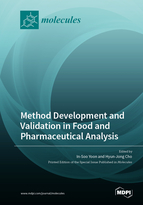Method Development and Validation in Food and Pharmaceutical Analysis
A special issue of Molecules (ISSN 1420-3049). This special issue belongs to the section "Analytical Chemistry".
Deadline for manuscript submissions: closed (31 December 2019) | Viewed by 139641
Special Issue Editors
Interests: bioanalysis; biopharmaceutics; DMPK; PBPK/PD modeling
Special Issues, Collections and Topics in MDPI journals
Interests: spectroscopy; imaging analysis; formulation; drug delivery system
Special Issues, Collections and Topics in MDPI journals
Special Issue Information
Dear Collegues,
Analytical chemistry is the study of separation, identification, and quantification of natural and artificial materials constituting one or more compounds or elements. Rapid growth in food and pharmaceutical industries and production of drugs and functional foods around the world has given rise to an inevitable demand to seek novel and systematic analytical techniques. As a consequence, analytical method development and validation have become a crucial prerequisite for achieving reliable analytical data required to support food and pharmaceutical development processes.
This Special Issue on “Method Development and Validation in Food and Pharmaceutical Analysis” will cover a wide range of topics including, but not limited to, new analytical and bioanalytical methods relevant to the separation, identification, and determination of substances in pharmaceutics, pharmacokinetics, nanobiotechnology, clinical chemistry, and related disciplines; methods for the identification of bioactive compounds in functional foods and medicinal plants; applications of chromatography and allied techniques in biomedical sciences.
We warmly invite our colleagues to submit their original contributions to this Special Issue in order to provide recent updates regarding analytical methods for drugs, biologics, phytochemicals, and other organic/inorganic materials related to food and pharmaceutical sciences that will be of interest to our readers. We would be delighted if you could respond to confirm your contribution and the proposed title by 30 September 2019 to assist in planning the whole project.
Prof. Dr. In-Soo Yoon
Prof. Dr. Hyun-Jong Cho
Guest Editors
Manuscript Submission Information
Manuscripts should be submitted online at www.mdpi.com by registering and logging in to this website. Once you are registered, click here to go to the submission form. Manuscripts can be submitted until the deadline. All submissions that pass pre-check are peer-reviewed. Accepted papers will be published continuously in the journal (as soon as accepted) and will be listed together on the special issue website. Research articles, review articles as well as short communications are invited. For planned papers, a title and short abstract (about 100 words) can be sent to the Editorial Office for announcement on this website.
Submitted manuscripts should not have been published previously, nor be under consideration for publication elsewhere (except conference proceedings papers). All manuscripts are thoroughly refereed through a single-blind peer-review process. A guide for authors and other relevant information for submission of manuscripts is available on the Instructions for Authors page. Molecules is an international peer-reviewed open access semimonthly journal published by MDPI.
Please visit the Instructions for Authors page before submitting a manuscript. The Article Processing Charge (APC) for publication in this open access journal is 2700 CHF (Swiss Francs). Submitted papers should be well formatted and use good English. Authors may use MDPI's English editing service prior to publication or during author revisions.
Keywords
- HPLC
- bioanalysis
- phytochemicals
- pharmacokinetics
- mass spectrometry
- functional food
- biopharmaceutics
- organic/inorganic materials
- imaging analysis
- spectroscopy








